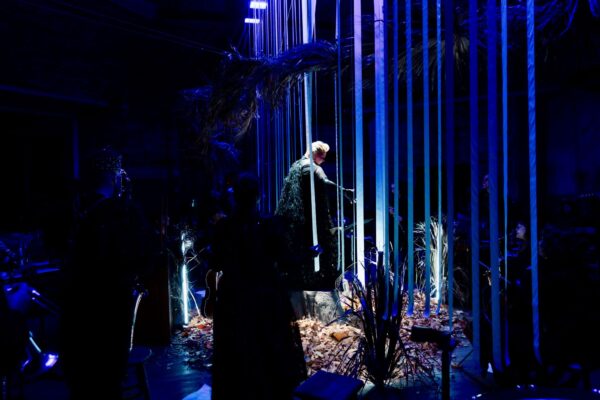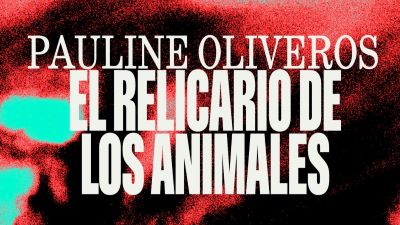THE WHINE OF THE ANIMALS
Long Beach Opera continued its season-long devotion to the work of Pauline Oliveros with El Relicario De Los Animales (The Shrine of the Animals), from 1979, with two performances last weekend at Heritage Square Museum, an open-air gem with eight Victorian-era buildings.
Sara Andon and Sidney Hopson
But before the opera, they staged an unrelated prologue throughout the grounds. Forming a goth procession, the performers walked up to the entrance, and then split off, setting up generic little scenes in different areas. On the porch of the first house, a violinist warmed up. On the next, a horny saxophonist and tubist pursued a soprano, who was more interested in the nearby fire hose than in them. The next house had two piccolos and a xylophone. There was an oboist in a casket and, on the hill, another saxophonist. The most interesting of all these scenelets were two cackling harpies having tea, which would have been perfect for Halloween. It was interesting being able to walk through the museum and listen to the musical landscape all around, but it was mostly lots of shrieking and honking. None of it made me want to stop and listen. I can’t stand it when mobile car detailers come to my street and set up shop with their noisy generators. Why would I pay to watch someone produce the same noise with a trombone?
Marlon Martinez and Kathryn Schulmeister
Brenda Rae and Pat Posey
The Shrine of the Animals took place in the church. It’s about a group of animals that gather so that, through sheer force of will, they learn to talk. Even though the show was staged in the round, staff advised people to sit in the area facing the windows. Why stage in the round if there’s a preferred view? The music began outside with some random honking and either tuning or playing. You never can tell with experimental music. Then the first players entered, blowing conch shells. (Ah, so they were playing and not tuning!) One by one, the players took their places, ending with mezzo-soprano Jamie Barton as the self-important priestess, who also led the ensemble. She quieted the playing, then cued everyone to detonate a bomb of noise with their instruments, as if told to just play something, anything, as loudly as possible.
Brenda Rae
The opera is plotless and, except for the end, wordless. The music is largely, if not entirely, improvised. Some of the musicians doubled as singers, but most of the singing was between Barton and soprano Brenda Rae. There was some kind of obscure structure, signified by Barton ringing a pair of tingsha (tiny cymbals), but it all sounded the same. One section had a bass-drum heartbeat and loud breathing. Another was heavy on screaming and squealing sax. Most of it was full-blast vocalizing and noise. Early on, the musicians “played” their instruments by holding them up and fingering them. Yes, it makes sounds, but it’s a gimmick that’s best left as exploration for conservatory students, and only them. Later, a player took apart her alto flute and blew into the mouthpiece. So innovative.
The Ensemble
Jamie Barton
Most of the singing took place between Barton and Rae, consisting of “ah” back and forth. It came across like an acting exercise, where each person has to respond immediately and authentically. Rae looked like she was in absolute ecstasy, a spellbound acolyte. However, her enthusiasm was directly proportional to my misery. Every now and then, the music threatened to become organized or grow into something, but it never did. It was all so wearyingly loud and repetitive.
Brenda Rae and Jamie Barton
Jamie Barton
At 45 minutes, the cacophony turned into the singers howling, “Words!” Not sarcastic “words,” but, literally, “Words!” Then the noise suddenly quieted, and the players left individually, droning on their instruments as they exited. Half the audience applauded as a formality. There were no bows.
I saw the Sunday matinee, which looked completely different than the photos that are included here, which were taken in the evening. Except for the strongest occasional floods of color, daylight in the church reduced Kaitlin Trimble’s lighting design to mostly ineffective accent lighting. Prairie T. Trivuth’s production design hinted at a post-human jungle setting with an antique dresser, leaves on the ground, and chains and palm fronds overhead. Costumes, by Chrisi Karvonides-Dushenko, were a miss, fatal for a conceptual show like this. All in black, with feathers, furs, and ruffles here and there, they merely hinted at animals; the whole time, I thought the performers were just gothy hipsters. Reliable Christopher Rountree was the music director, but animal sounds were far from my mind while being assaulted by this. Long Beach Opera Artistic Director and Chief Creative Officer James Darrah produced and directed, utterly failing to convince me why I shouldn’t be aghast that the company is devoting an entire season to this composer. I can imagine a production where animals, who are identifiable as animals, struggle to overcome their animal sounds, building to a cathartic release when they finally talk. Instead, I got a headache that lasted three days.
 Jamie Barton
Jamie Bartonphotos by JJ Geiger
El Relicario de Los Animales (1979)
Long Beach Opera
Heritage Square Museum, 3800 Homer St. in Los Angeles
reviewed (and closed) on February 16, 2025
for more info, visit LBO or Pauline Oliveros


{ 1 comment… read it below or add one }
Pauline Oliveros’s music tends to sound deep but adds up to navel-gazing drift. Her fixations on “deep listening” come across as rationalization for directionless drones and random sonic experimentation instead of as fierce compositional discipline.
Though she styled herself as a “revolutionary” amidst experimental musicians, a lot of her music is as concerned with conception as realization, challenging the listener’s patience instead of demanding attention. The distinction between meditative and monotonous disappears early, and one cannot help but speculate whether the emperor wore any clothes to begin with.
I am appalled that Long Beach Opera hired two world-class soloists to “star” in this fiasco.